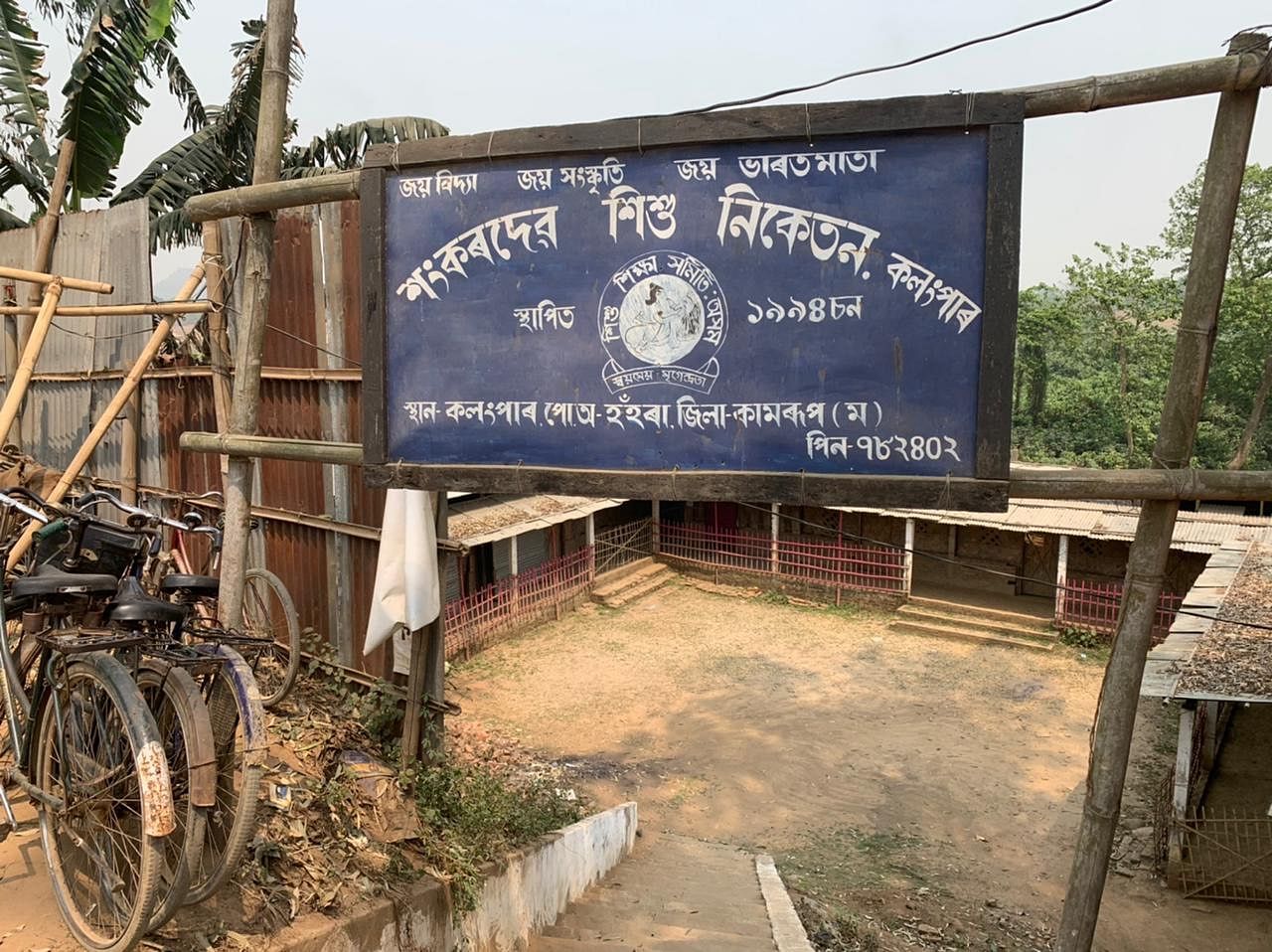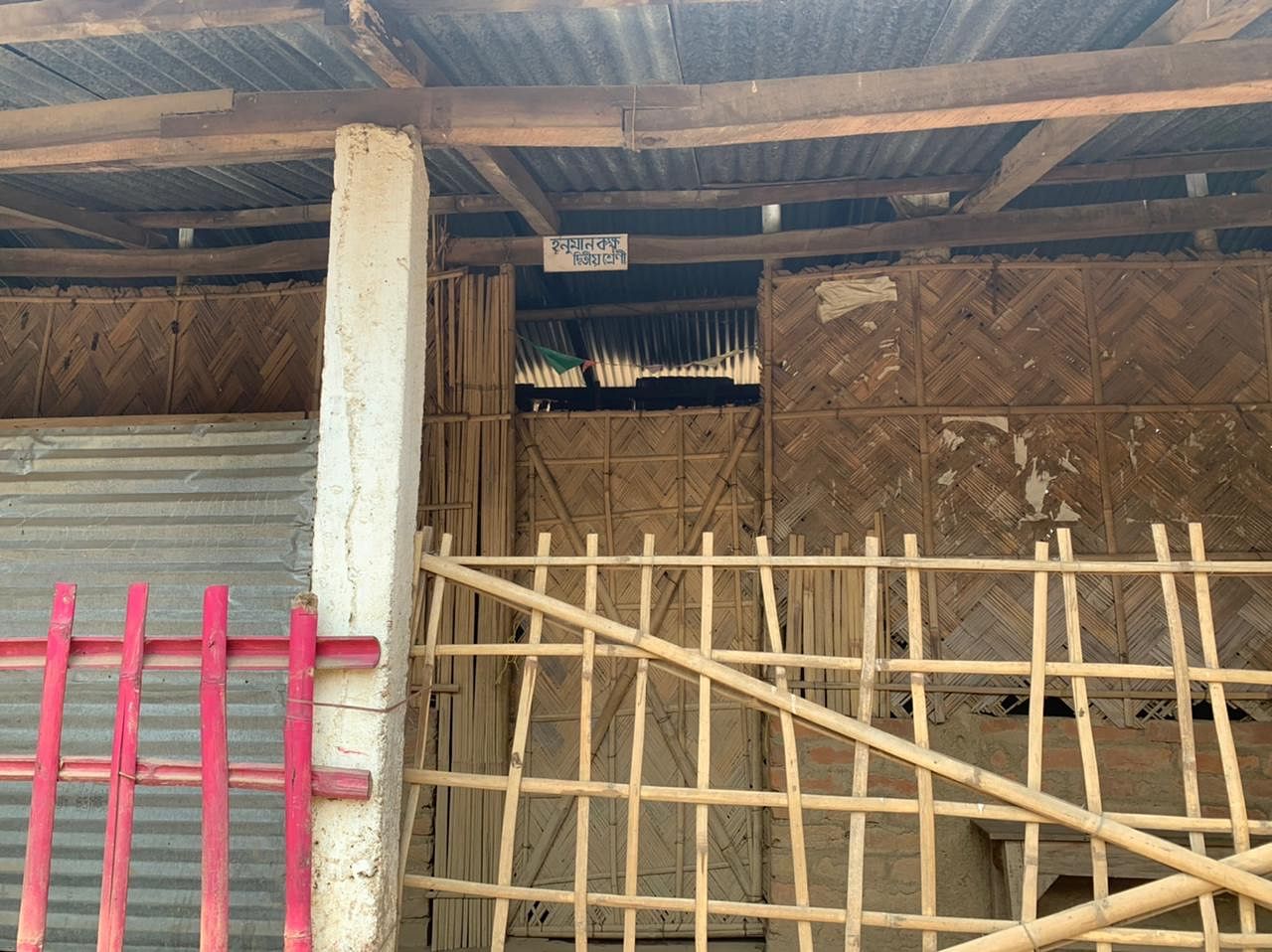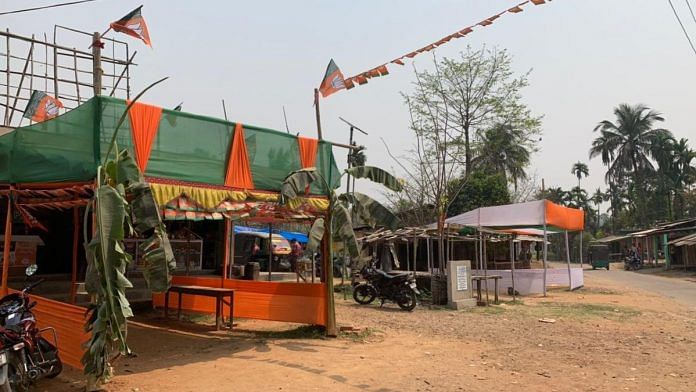Guwahati: The rise of the Bharatiya Janata Party (BJP) to power in Assam is attributed to many factors — nationwide yearning for change with Narendra Modi’s ascension to power in Delhi, Amit Shah’s acumen as a political strategist, his finding of an ambitious Congressman, Himanta Biswa Sarma, and the Congress’ inability to cope with the changes. Yet, all these together don’t tell the entire story.
The groundwork for Hindutva’s spread in Assam started long back — 20 years before Shah was born and 25 years before Sarma’s birth. It was in 1944 when Ram Singh Thakur, a pracharak of the Rashtriya Swayamsevak Sangh (RSS), set foot in Assam. Two years later, another batch of pracharaks from Maharashtra landed. And then more and more batches from different states.
The next seven decades have been a story of unrelenting, arduous efforts to propagate the ideology of the RSS among an ethnically, linguistically diverse population.
A 10-room thatched school building, Sankardeva Shishu Niketan, Kolungpur, about 35 km east of Guwahati, stands testimony to the RSS’ hard work on the ground. The school is named after Srimanta Sankardeva, a 15th-century saint reformer who is a cult figure in Assam’s cultural history.

The school was founded in 1994 by Vidya Bharti, an RSS affiliate. Sign plates outside the classrooms show an effort to assimilate diverse cultural, historical backgrounds: Shri Krishna Section, Class 1; Hanuman section, Class 2; Kanaklata section (named after an Assamese freedom fighter who was shot dead by the British police while she was leading a procession holding a national flag) Class 5; and, among others, Bishnu Prasad Rabha section (named after an Assamese cultural icon) Class 7.

Rinku Monidas, the school principal, says their 182 students are from all communities — Karbis, Bodos, and Bengali Hindus, among others. There are 14 teachers with monthly salaries ranging from Rs 2,200 to 2,400.
Simpi Das, a political science undergraduate student and aspiring lawyer, says people in her neighbourhood didn’t know about the Ramayana and the Mahabharata, which she learnt by heart at this school.
Gayatri Mantra and Saraswati Vandana are part of the prayers that end with the singing of Vande Mataram. On Saturdays, they sing Jana Gana Mana. Simpi, who attended two RSS workshops for 15 and 5 days, says many Muslim students have joined another Sankardeva school a few kilometres away.
Vidya Bharti runs 115 such middle schools across Assam. It also runs 121 primary and 341 secondary schools, as well as one senior secondary institute. There are 1.7 lakh students enrolled in them. Then there are 540 ekal vidyalayas or single-teacher schools.
Other RSS affiliates such as the Vanvasi Kalyan Ashram, the Seva Bharti, and the Vishva Hindu Parishad (VHP) have also been working on the ground for decades.
Also Read: In Congress-AIUDF alliance, Assam’s Muslims see hope to keep vote intact, defeat BJP
Schools, mass weddings and health aid
The VHP runs dozens of schools and hostels as also 3,200 ekal vidyalayas. Ramanand Sharma, a VHP functionary from Uttar Pradesh who came to Assam in 1975, says when he first arrived here, there were just two categories of people — “Christians and non-Christians”. Things have changed now, he adds.
The VHP opened its first hostel for students at Haflong in Dima Hasao district in the 1970s. In the next four decades, it started four more schools and hostels in this Dimasa tribe-dominated district and many more elsewhere in the state.
Dinesh Tiwari, regional organiser of the VHP in Assam, told ThePrint that after 1985, the VHP embarked on the “Banswara Pariyojana”, sending children from the northeast to its residential school in Rajasthan’s Banswara.
First, the students are taught in village schools run by the VHP and other RSS affiliates and then brought to the district headquarters to study in residential schools before many of them are sent out of the state. Tiwari says 5,000 children from Assam and other northeastern states have been sent to schools in Rajasthan, UP and other states. Many of them come back home to open their own schools.
“This huge network of schools in every nook and corner has helped the RSS to spread its ideology and create space for the BJP’s electoral politics. The RSS’ penetration actually came during the Assam movement,” said Professor Bhupen Sarmah, former director of the OKD Institute of Social Change and Development, a Guwahati-based research institute.
“In Assam, the issue of illegal immigration is equal to Bangladeshis, which is equal to Muslims. It was, therefore, not difficult for the RSS to project Muslims as a threat to the Assamese cultural identity,” he added.
A member of the North East Centre, a Delhi-based think tank, confirmed the active role played by RSS student wing Akhil Bharatiya Vidyarthi Parishad (ABVP) in the Assam Movement (1979-85) against foreigners. The ABVP organised workshops for leaders of the All Assam Students’ Union (AASU), which was spearheading the movement, across the country.
“We have nothing to do with the BJP or politics. That’s how the media distorts the Sangh’s contributions to society. Yes, if some Muslims capture someone’s land, we do intervene. If a Muslim abducts someone’s wife or daughter and the administration stays silent, we must tell them what to do within the framework of the Constitution,” Dinesh Tiwari of the VHP told ThePrint.
The VHP’s youth wing, Bajrang Dal, has a wide network in Assam, with around 8,000 people in its committees.
The Vanvasi Kalyan Ashram, another RSS-affiliated organisation working in tribal areas, has been active in Assam since 1978. It’s running 26 boys’ and girls’ hostels in Dima Hasao, Silchar, Hailakandi and other places. It also runs Bal Samskar Kendras, which “prepare” children for schools by organising games, singing prayers and bhajans, and teaching them “how to become good human beings”.
It has been active in Assam’s tea gardens for over three decades. A Kalyan Ashram functionary told ThePrint how they organise “samuhik vivah” or mass marriage of tribals. “There is this unique thing prevalent in tea gardens. Some men and women live together and even have children but they don’t get social acceptability. We organise samuhik vivah for them and give household goods worth Rs 25,000 to each of these couples.”
Another RSS affiliate, Seva Bharti, has been working in the health sector in Assam since 1998. It has “arogya mitras” or health professionals, trained by the organisation, in 3,500 villages.
The Seva Bharti distributed Arsenicum Album, a purported homoeopathy medicine for “prevention and treatment” of Covid-19, among one lakh people in February-March last year. “Ninety-eight per cent of the people who we gave this medicine didn’t get corona,” said Dr Arun Kumar Banerjee, another Seva Bharti functionary who quit his job as a lecturer in Hooghly to come to work in Assam in 1998.
The organisation also holds Dhanwantari Seva Yatra in Assam, bringing doctors from across the country to people’s doorsteps.
Also Read: Modi-Shah’s chemistry-vs-arithmetic theory is in for a tough test in Assam polls
RSS goodwill
Travel to any village in Assam and the RSS is present in various other forms, running yoga centres and skill development programmes like tailoring and bamboo furniture-making, holding “character-building” classes for children of 4-14 years and teenage girls, and even planting trees in houses.
When Amit Shah took over the reins of the BJP in 2014 and started looking east for expansion, all he had to do was project the BJP as the rightful political inheritor of the goodwill the RSS earned over decades.
Edited by Sunanda Ranjan
Also Read: 13 parties are fighting Assam elections — who they are, and how state has voted in the past




definite change . all along newspapers like those projected RSS as a sly facist hatemongering organization and now suddenly a u-turn in recognizing their work.
the photograph of the school says the village where Shankardeo Shishu Niketan is Kolang Paar not Kolungpur. Kolungpur is in Sonapur area, while Kalangpaar is in Hahara. This tells a lot about the standard of reporting.
Havingi worked for 11 years in Assam as an RSS worker, I must say the knowledge of the mediapersons, especially the state correspondents who come from Delhi to represent national media is dismal. They only analyse the politics in terms of the number of seats won. They almost always ignore the micro-level stories. These reporters don’t even remember that Tarun Gogoi in 2016 said that the Congress lost because it underestimated the Shankardeo Shishu Niketans.
The correspondent doesn’t know the volume of work that RSS has done in North East to earn people’s respect. He talks about Thakur Ram Singh, whom I saw in person. He doesn’t talk about the number of pracharaks and young local lads who were killed by ULFA, NLFT and other terror groups.
Sir,
Appreciate your great contribution.
With out RSS , congress must have sold Assam to Bangladeshi Muslims for their vote bank politics.
Is it not a sad comment on Indian journalism that what was being done by RSS last 95 years is now seen/acknowledged ?
The quiet RSS has been going since its inception. The good will earned in situation of earth quakes, floods just kept on accumulating.
Modi was aware of existence of that good will as a full time Pracharak. He got his chance to prove himself in Gujrat and has not looked back since.
Great work by all these Organisations
Without mention of Ashok Singhal’s gigantic work, the post is incomplete. He started sending teenagers to the schools, run in almost every district headquarters in Western Uttar Pradesh districts exclusively for boys coming from Assam. It is good that the post did not carry the smug claim of Ram Madhav for pioneering the grand victory of the BJP five years ago.